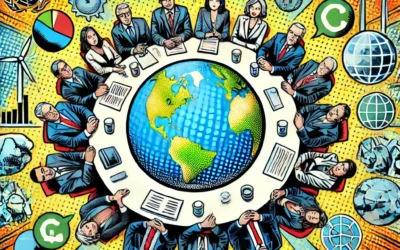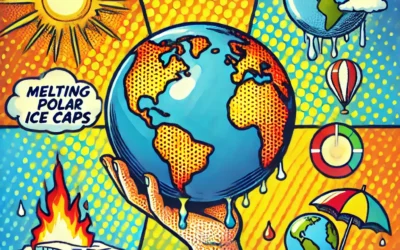The Causes of the Climate Crisis
The climate crisis is primarily driven by human activities that increase the concentration of greenhouse gases in the atmosphere. The most significant contributors to this crisis include the burning of fossil fuels, deforestation, and industrial processes.
1. Fossil Fuels
The combustion of fossil fuels, such as coal, oil, and natural gas, for energy and transportation is the largest source of greenhouse gas emissions. These activities release carbon dioxide (CO2) and methane (CH4), two of the most potent greenhouse gases, into the atmosphere. The resulting increase in global temperatures is a key factor driving the climate crisis.
2. Deforestation
Deforestation, the large-scale clearing of forests, contributes significantly to the climate crisis by reducing the planet’s capacity to absorb CO2. Forests act as carbon sinks, storing large amounts of carbon that would otherwise remain in the atmosphere. When forests are destroyed for agriculture, logging, or urban development, this stored carbon is released, exacerbating global warming.
3. Industrial Processes
Industrial activities, including cement production, chemical manufacturing, and metal processing, are major sources of greenhouse gas emissions. These processes often involve the burning of fossil fuels and the release of other pollutants that contribute to the climate crisis. Efforts to reduce industrial emissions are essential for mitigating the impact of climate change.
The Impacts of the Climate Crisis
The climate crisis is already having profound effects on the environment, human health, and economies worldwide. Understanding these impacts is crucial for developing effective strategies to address the crisis.
1. Extreme Weather Events
The increasing frequency and intensity of extreme weather events, such as hurricanes, heatwaves, droughts, and floods, are among the most visible impacts of the climate crisis. These events cause widespread damage to infrastructure, disrupt food and water supplies, and pose significant risks to human health and safety.
2. Rising Sea Levels
Rising sea levels, driven by the melting of polar ice and glaciers, are a direct consequence of the climate crisis. Coastal communities are particularly vulnerable, as higher sea levels increase the risk of flooding, storm surges, and the loss of land. The displacement of populations due to rising sea levels is already becoming a reality in some regions.
3. Loss of Biodiversity
The climate crisis is contributing to a rapid loss of biodiversity, as species struggle to adapt to changing temperatures and habitats. Ecosystems that are unable to adjust to the changing climate face the threat of collapse, leading to the extinction of species and the disruption of ecological balance. Protecting biodiversity is essential for maintaining the resilience of ecosystems and the services they provide.
4. Economic Impacts
The economic impacts of the climate crisis are far-reaching, affecting industries, trade, and livelihoods. Agriculture, in particular, is highly vulnerable to climate change, as shifts in weather patterns can disrupt crop production and lead to food shortages. The cost of responding to extreme weather events and adapting to climate impacts is also placing significant strain on economies, particularly in developing countries.
Addressing the Climate Crisis: Solutions for a Sustainable Future
Addressing the climate crisis requires a comprehensive approach that includes reducing greenhouse gas emissions, enhancing resilience, and promoting sustainable practices. The following strategies are key to mitigating the effects of climate change and building a sustainable future.
1. Transitioning to Renewable Energy
One of the most effective ways to combat the climate crisis is by transitioning from fossil fuels to renewable energy sources, such as solar, wind, and hydropower. Renewable energy generates electricity without emitting greenhouse gases, making it a crucial component of any climate action plan. Governments and businesses must invest in the development and deployment of renewable energy technologies to reduce reliance on fossil fuels.
2. Promoting Energy Efficiency
Improving energy efficiency is another critical strategy for addressing the climate crisis. By using energy more efficiently in buildings, transportation, and industry, we can reduce overall energy consumption and lower greenhouse gas emissions. Energy-efficient technologies, such as LED lighting, electric vehicles, and smart grids, are essential for achieving significant reductions in emissions.
3. Protecting and Restoring Ecosystems
Protecting and restoring natural ecosystems, such as forests, wetlands, and oceans, is vital for mitigating the climate crisis. These ecosystems act as carbon sinks, absorbing CO2 from the atmosphere and helping to regulate the global climate. Conservation efforts, reforestation projects, and the protection of marine environments are essential for preserving the planet’s natural carbon balance.
4. Supporting Climate-Resilient Development
Building resilience to the impacts of the climate crisis is essential for protecting vulnerable communities and ecosystems. This involves developing infrastructure that can withstand extreme weather events, implementing early warning systems, and promoting sustainable agricultural practices that can adapt to changing climate conditions. Climate-resilient development is particularly important for developing countries that are disproportionately affected by climate change.
5. Implementing Climate Policies and Regulations
Governments play a crucial role in addressing the climate crisis by implementing policies and regulations that limit greenhouse gas emissions and promote sustainable practices. Carbon pricing, emissions trading systems, and renewable energy mandates are examples of policy tools that can drive the transition to a low-carbon economy. International agreements, such as the Paris Agreement, are also essential for coordinating global efforts to combat climate change.
The Role of Individuals in Combating the Climate Crisis
While large-scale policy changes and technological innovations are essential, individuals also play a vital role in addressing the climate crisis. By making more sustainable choices in their daily lives, individuals can contribute to reducing greenhouse gas emissions and promoting environmental stewardship.
1. Reducing Personal Carbon Footprint
Individuals can reduce their carbon footprint by adopting more sustainable behaviors, such as using public transportation, reducing energy consumption at home, and choosing a plant-based diet. These actions, when adopted collectively, can have a significant impact on reducing greenhouse gas emissions and mitigating the effects of the climate crisis.
2. Supporting Sustainable Products and Companies
Consumers can drive change by supporting companies and products that prioritize sustainability. By choosing products made from recycled materials, buying from companies with strong environmental commitments, and reducing overall consumption, individuals can help create a market demand for more sustainable practices.
3. Advocating for Climate Action
Advocacy is another powerful tool for addressing the crisis. By raising awareness, participating in climate marches, and engaging with policymakers, individuals can help shape public opinion and influence government decisions on climate policy. Grassroots movements and environmental organizations rely on the collective power of individuals to push for meaningful climate action.
Conclusion
The climate crisis represents one of the greatest challenges of our time, but it also presents an opportunity for transformative change. By addressing the root causes of the crisis and implementing effective solutions, we can mitigate its impacts and build a more sustainable and resilient future. Governments, businesses, and individuals all have a role to play in combating the climate crisis, and together, we can create a world that is better prepared to face the challenges ahead.







